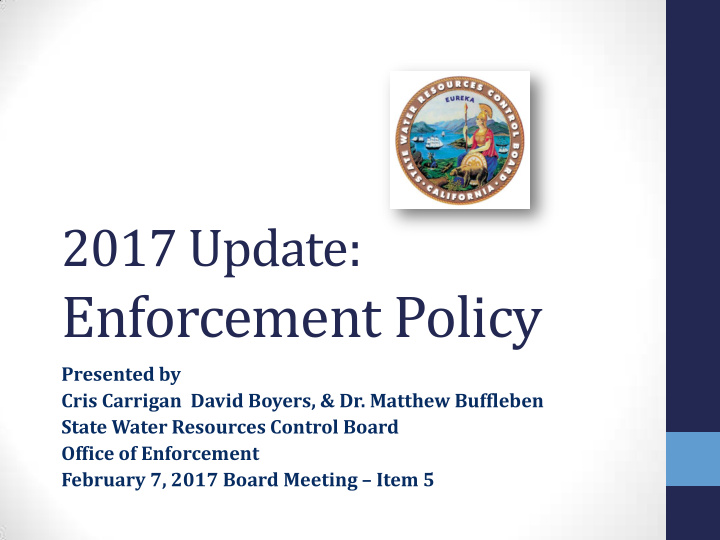



2017 Update: Enforcement Policy Presented by Cris Carrigan David Boyers, & Dr. Matthew Buffleben State Water Resources Control Board Office of Enforcement February 7, 2017 Board Meeting – Item 5
2017 Enforcement Policy Highlights Adjusts the Regional Boards’ established process for ranking enforcement priorities based on actual or potential impact to the beneficial uses, or the regulatory program, & for using progressive levels of enforcement , to achieve compliance. Fine tunes the administrative civil liability assessment methodology to facilitate a more fair, transparent, & consistent statewide approach to liability assessment. Recognizes the use of alternatives to civil liabilities , such as supplemental environment projects (SEPs), compliance projects, & enhanced compliance actions, but requires standards for approving alternatives to ensure they provide the expected benefits. 2 Promotes environmental justice policies adopted by the Water Boards.
Discretionary Enforcement Goals Identify the greatest needs; Deter harmful conduct; Encourage the regulated community to anticipate, identify, & correct violations; Achieve maximum water quality benefits; Protect the public. 3
2017 Policy Proposed Changes Focus on Transparency and Fairness Prioritize Cases – After Categorizing Violations Fine Tune Penalty Calculation Methodology Further Environmental Justice & Human Right to Water 4
Prioritizing Cases Quarterly Prioritization Meetings & Appoint an Enforcement Coordinator; Change Violation Ranking to Two, v. Three Classes; Eliminate use of data algorithms. 5
Factors For Prioritizing Enforcement Identifying the highest priority cases; Magnitude of violations & threat to beneficial uses; Did violations harm a sensitive water body? Did violations continue after being brought to the attention of the entity? Is there a good-faith effort to correct the violation? Are there facts mitigating the violations? What is the strength of the evidence? 6 Are enforcement resources available?
Prioritizing Enforcement OE Assistance The Office of Enforcement has an attorney- liaison assigned to each regional board – on call. The attorney- liaison participates in a monthly meeting assisting with prioritizing cases for enforcement. OE advises the AEO who makes all strategic decisions on the case. 7
ASSESSING A DISCRETIONARY ACL The Enforcement Policy recognizes each Regional Board and each case, is unique. The Policy Seeks to Balance Fact Specificity with Fairness and Consistency in a Transparent Manner. AEO & Staff Apply the Methodology – Same as the Board. 8
WATER CODE 13385 FACTORS The nature, extent, circumstances • and gravity of the violation; Whether susceptible to cleanup or • abatement; The degree of toxicity • Ability to pay; • Voluntary cleanup efforts; • Prior history of violation; • Degree of culpability; • Economic benefit; and • 9 Other factors as justice may require. •
Calculating Penalties Switch order of Steps 1 & 2 ; Determine toxicity prior to discharge; Clarify potential for harm is an appropriate measure; Harmonize the six categories of harm/potential for harm to threat assessment. 10
Calculating Penalties Redefine “Susceptibility to Cleanup” Smooth out the curve in Table 1 Redefine “High Volume Discharges” Reframe harm for Non-Discharge violations History of Violations 11 Multiple-Day Violations
Calculating Penalties Ability to Pay Other Factors Justice May Require 12
Assessing ACLs --Settlement Engage with the Discharger; Re-evaluate the Methodology; Determine a range of possibilities. 13
Assessing ACLs--Settlement Offers Outside the Range to the Board; Contested ACLs Settle at the Medium-to - High End; Engagement Continues (the Zero Sum Game) Hearing Procedures 14
ENVIRONMENTAL JUSTICE Ensure the fair treatment of people of all races, cultures, and income levels, including minority and low-income populations in the state. Requires Greater Focus on Compliance Assistance & Progressive Enforcement. 15
ENVIRONMENTAL JUSTICE • Work with DFA on Financial Assistance; • Allow ECAs in Excess of 50% of Total Liability; • Expand Considerations to Include All Service Providers in DACs, including Public Water Systems and MS4s; • Expand Considerations to All Disadvantaged Communities Regardless of Size. 16
THE HUMAN RIGHT TO WATER • Violation of the Human Right to Water for purposes of this Policy is one where the violation results, or threatens to result, in the denial of one’s human right to water. • Violations of the Human Right to Water are considered as a factor in prioritizing discretionary enforcement • Violations of the Human Right to Water will be specifically tracked and publicly accessible in CIWQS. 17
PROCEDURAL CONSIDERATIONS Comment period 146 days - extended twice; About 50 public comments received; Complete responses to all comments ; Policy goes to Office of Administrative Law. 18
RECOMMENDED ADDITIONAL CHANGES BASED ON COMMENTS • Added a Definition of Human Right to Water Violation and a commitment to work with OIMA to track HRtW violations in CIWQS; • Added language to include public water systems and MS4 operators who serve disadvantaged communities in provisions relating to environmental justice; • Changed violation classifications from “1” and “2” to A and B; • Clarified that Class A violations may be Class B in unusual, 19 unique or exceptional circumstances.
Questions & Comments? Cris.Carrigan@waterboards.ca.gov David.Boyers@waterboards.ca.gov 20 Matthew.Buffleben@waterboards.ca.gov
Recommend
More recommend